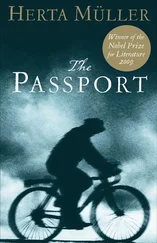The other white slag was deposited in a series of man-high heaps beside the yama. That slag wasn’t baked solid, the piles were edged with grass. If it rained hard while we were shoveling coal we took shelter in these heaps. We burrowed into the white slag, and it trickled back on top of us, covering us up. In winter, steam rose off the snow on top of the pile, while we warmed ourselves in our holes and were three times hidden: under the snow blanket, inside the slag, and wrapped in our fufaikas. The steam passed through every layer, and there was a cozy, familiar smell of sulfur. We sat buried up to our noses, which stuck out of the ground and broke through the melting layer of snow like bulbs that have sprouted too early. When we crawled out of the slag heaps, our clothes were riddled with holes from the tiny embers, and the padding came spilling out of our jackets.
From all my loading and unloading I was well acquainted with the rust-colored, ground-up slag from the blast furnace. That slag has nothing to do with the white kind, it’s composed of reddish-brown dust that ghosts through the air with every swing of the shovel and slowly settles like falling folds of cloth. Because it’s as dry as the hot summer and thoroughly aseptic, the blast-furnace slag has no bearing on homesickness.
Then there’s the solidly baked greenish-brown slag in the overgrown meadow, in the wasteland behind the factory. Under the weeds it looked like broken lumps of salt lick. That slag and I had nothing to do with each other, it let me pass without making me think of anything in particular.
But my one-and-only slag, my daily slag, the slag of my day and night shift was the clinker-slag from the boilers at the coal furnaces, the hot and cold cellar slag. The furnaces stood above us, in the world of the living, five to a row, each several stories tall. They provided heat to the boilers, producing steam for the entire plant and hot and cold slag for us in the cellar. They also provided all our work, the hot phase and the cold phase of every shift.
Cold slag can only come from hot slag, it’s nothing more than the dusty residue left when hot slag cools. Cold slag only has to be emptied once per shift, but the hot clinker-slag requires constant removal, following the rhythm of the furnaces. It has to be shoveled onto countless little rail-carts, then pushed to the top of the mountain of slag at the end of the tracks and dumped.
The hot slag changes from day to day, depending on the mix of coal, which can be kind or malicious. If it’s a good mix, the glowing slabs that drop onto the transfer grate are four to five centimeters thick. Having expended their heat, they are brittle and break into pieces that fall easily through the hatch, like toasted bread. The hunger angel is amazed to see how quickly the little carts get filled even when we’re weak from shoveling. But if the mix is bad, then the slag doesn’t form clinkers and comes out like sticky, white-hot lava. It doesn’t fall through the grate on its own but gets clogged in the furnace hatches. You have to use a poker to tear off clumps that stretch like dough. You can’t get the oven empty or the cart full. It’s an agonizing, time-consuming job.
If the mix is catastrophic, then the furnace gets a real case of diarrhea. Diarrhea slag doesn’t wait for the hatch to open, it spurts out of the half-opened doors like shitted-out corn kernels. This slag is dangerous, it glows red and white and shouldn’t be looked at, and it can find its way through every hole in your clothes. The flow can’t be stopped, so the cart gets buried underneath. Somehow—the devil only knows how—you have to close the hatch, protect your legs, galoshes, and footwraps from the blazing flood, douse the blaze with the hose, dig out the little cart, push it up the mountain, and clean up after the accident—all at the same time. And if on top of everything else, this happens toward the end of your shift, then it’s an absolute disaster. You lose an endless amount of time, and the other furnaces aren’t going to wait for you, they need emptying, too. The rhythm becomes frantic, your eyes are swimming, your hands are flying, your feet are shaking. To this day I hate the diarrhea slag.
But I love the once-per-shift slag, the cold slag. It treats you decently, patiently, and predictably. Albert Gion and I needed each other only for the hot slag. For the cold slag we each wanted to be by ourselves. The cold slag is tame and trusting, almost in need of affection—a violet sand-dust that you can easily be left alone with. The cold slag comes from the last row of furnaces at the very back of the cellar, it has its own special hatches and its own little tin-bellied cart without bars.
The hunger angel knew how happy I was to be left alone with the cold slag. That it wasn’t really cold but lukewarm and smelled a little like lilacs or fuzzy mountain peaches and late-summer apricots. But mostly the cold slag smelled of quitting time, because the shift would be over in fifteen minutes and the danger of a disaster was past. The cold slag smelled of going home from the cellar, of mess-hall soup, and of rest. It even smelled of civilian life, and that made me cocky. I imagined that I wasn’t going from the cellar to the barrack in a padded suit, but that I was all decked out in a Borsalino, a camel-hair coat, and a burgundy silk scarf, on my way to a café in Bucharest or Vienna where I was about to sit down at a little marble-top table. So easygoing was the cold slag that it helped feed the delusions you needed in order to steal your way back into life. Drunk on poison, you could find true happiness with the cold slag, dead-sure happiness.
Tur Prikulitsch had reason to think I would complain. That’s why he asked me every few days at the barber’s:
Well, how is it down there in the cellar.
How are things going in the cellar.
How’s the cellar doing.
Are things all right in the cellar.
Or just: And in the cellar.
And because I wanted to beat him at his own game, I always stuck to the same answer: Every shift is a work of art.
If he’d had the slightest idea about the mix of hunger and coal gases, he would have asked me where I spent my time in the cellar. And I could have said, with the fly ash, because fly ash is another type of cold slag, it drifts everywhere and coats the entire cellar with fur. You can find true happiness with fly ash, too. It isn’t poisonous, and it flutters about, mouse-gray and velvety. The fly ash doesn’t smell. It’s made up of minuscule pieces, tiny scales, that constantly flit around, attaching themselves to everything, like frost crystals. Every surface gets furred. The fly ash turns the wire mesh around the lightbulb into a circus cage complete with fleas, lice, bedbugs, and termites. Termites have wedding wings, I learned in school, and they live in camps. They have a king, a queen, and soldiers. And the soldiers have big heads. There are jaw soldiers, nozzle soldiers, and gland soldiers. And they’re all fed by the workers. And the queen is thirty times bigger than the workers. I imagine that’s also the difference between the hunger angel and me. Or Bea Zakel and me. Or Tur Prikulitsch and me.
On contact with water, it’s not the water that flows but the fly ash, because it sucks up the water and swells into formations, like in a cave. The formations can look like stacks of dishes or, if they’re very big, like cement children eating gray apples. Fly ash mixed with water can work magic.
But without light and water, the fly ash just sits there, dead. On the cellar walls it looks just like real fur, on your padded cap like artificial fur, in your nostrils like rubber plugs. Albert Gion’s face is black, in the cellar it disappears, all I see are the whites of his eyes and his teeth swimming through the air. With Albert Gion I never know if he’s sad or simply withdrawn. When I ask, he says: I don’t give it any thought. We’re just two pill bugs underground. Seriously.
Читать дальше












